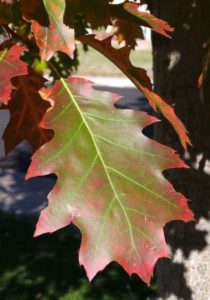 The leaves have been falling like a downpour and a mild weekend ahead means there may be a lot of leaf raking and bagging in most neighborhoods. But before you rake, bag and stash those leaves on the curb to end up in the landfill, lend an ear to what the US Composting Council (USCC) says about sending yard debris to the landfill.
The leaves have been falling like a downpour and a mild weekend ahead means there may be a lot of leaf raking and bagging in most neighborhoods. But before you rake, bag and stash those leaves on the curb to end up in the landfill, lend an ear to what the US Composting Council (USCC) says about sending yard debris to the landfill.
According to USCC, landfilling yard debris is a “wasteful use of resources.” Instead, they encourage recycling yard debris – including leaves – into compost that can “enhance the health of our soils and plants and protect our water resources.”
So tomorrow morning, when you had planned to rake and bag those leaves, ask yourself, “What can I do with them instead?”
Here are some easy-to-do tips that will help keep more resources in your yard where they can work for you and your landscape:
#1 – Fallen leaves left on the lawn will become a matted mess once they become wet with rain or snow. Matted leaves can smother the soil and create snow mold or other problems in the lawn. As we’ve often recommended, rake leaves onto the lawn and mow over them with a mulching mower. If you have trees with large leaves, such as catalpa, maple or cottonwood, this is an effective way to deal with them.
#2 – Rake out excess mulched leaves and use them as organic matter. Work mulched leaves into the soil in the veggie garden and annual beds. Over the winter these bits of leaves will decompose and improve soil quality.
#3 – Mulched and very small leaves, such as honey locust and ash leaves, can also be placed around the bases of roses, grapes and other perennials as winter mulch. Mound them around the bases of plants while they are still dry.
#4 – Still have too many leaves and no place to put them? Get them to a recycling center so they don’t end up in a landfill. Refer to this list of recycling centers in Colorado as many accept centers tree debris, including leaves.
Scientifically speaking
Leaves in the landfill contribute to landfill-generated methane emissions which heighten global warming, says USCC. Yet when organic materials decompose naturally, the carbon dioxide they release is part of the natural flow of carbon dioxide between vegetation and the atmosphere which has little impact on global warming.
What we do in our own backyards really does matter for our world.
